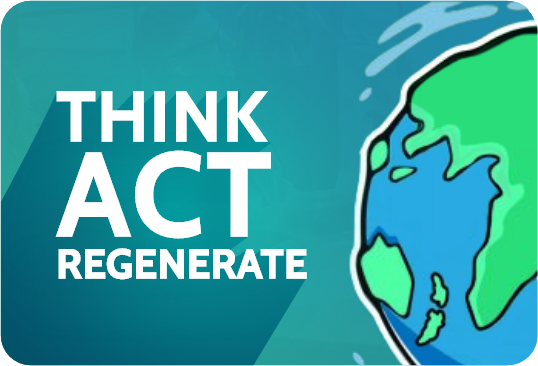
THINK ACT REGENERATE is a podcast by Leigh Baker of ThinkActRegenerate which explores the wealth of regenerative design solutions happening on the ground in Australia and New Zealand, as well as around the world.
Humans have been copying nature for millenia – but we gave it a back seat at the start of the Industrial Revolution. Now it’s back – and offering a wealth of regenerative innovation opportunities for products, processes and systems design.
Nature’s “superpower” is to create solutions at room temperature, using renewable resources and renewable energy.
In this episode, host Leigh Baker of Think Act Regenerate discusses how Biomimicry-based design can be used to uncover smart regenerative business opportunities.
FULL TEXT: https://thinkactregenerate.com/insight-using-biomimicry-to-find-regenerative-business-opportunities/#text
CREDITS
Original music composed for the show by Ian Hopkinson of HopkinsonCreative.com – used with permission.
LINKS
Resources
AskNature solutions library: asknature.org
Bioneers Action Hub: bioneers.org
Biomimicry Toolbox: https://toolbox.biomimicry.org/methods/define/
Economics of Biomimicry:
https://infomineo.com/sustainable-development/bioinspired-innovation-harnessing-natures-wisdom/
ThinkActRegenerate INSIGHTS: https://thinkactregenerate.com/INSIGHTS/
Regenerative Thinking in Action: https://thinkactregenerate.com/program/
Examples
Bardee (black soldier fly): https://www.bardee.com/collections/all
Fungi Solutions: https://www.fungisolutions.com.au/
Interface Factory as Forest:
https://trellis.net/article/inside-interfaces-bold-new-mission-achieve-climate-take-back/
Kalundborg Symbiosis Industrial Estate: https://www.symbiosis.dk/en/
Mycellium (mushroom) products: https://myceliuminspired.com/products
Samsara (enzymatic plastic recycling):
https://www.samsaraeco.com/
Zeoform:
https://zeoform.com/zeoboard

Humans have been copying nature for millenia – but we gave it a back seat at the start of the Industrial Revolution. Now it’s back – and offering a wealth of regenerative innovation opportunities for product, process and systems design.
Nature’s “superpower” is to create solutions at room temperature, using renewable resources and renewable energy. It’s one that a new generation of entrepreneurs has been applying to regenerative business innovation for decades.
In this episode of the Think Act Regenerate podcast, we explore how biomimicry-based design can be used to uncover a broad selection of regenerative business opportunities.
CREDITS
Original music composed for the show by Ian Hopkinson of HopkinsonCreative.com – used with permission.
LINKS
Resources
AskNature solutions library: asknature.org
Bioneers Action Hub: bioneers.org
Biomimicry Toolbox: https://toolbox.biomimicry.org/methods/define/
Economics of Biomimicry: https://infomineo.com/sustainable-development/bioinspired-innovation-harnessing-natures-wisdom/
ThinkActRegenerate INSIGHTS: https://thinkactregenerate.com/INSIGHTS/
Regenerative Thinking in Action Program: https://thinkactregenerate.com/program/
Examples
Bardee (black soldier fly): https://www.bardee.com/collections/all
Fungi Solutions: https://www.fungisolutions.com.au/
Interface Factory as Forest: https://trellis.net/article/inside-interfaces-bold-new-mission-achieve-climate-take-back/
Kalundborg Symbiosis Industrial Estate: https://www.symbiosis.dk/en/
Mycellium (mushroom) products: https://myceliuminspired.com/products
Samsara (enzymatic plastic recycling): https://www.samsaraeco.com/
Zeoform: https://zeoform.com/zeoboard
TRANSCRIPT
Hello there. I’m Leigh Baker, your host for this episode of the Think Act Regenerate podcast, where we explore the rich smorgasbord of opportunities offered by today’s regenerative solutions. This podcast episode was recorded and produced on Wurundjeri lands on the edge of Naarm, Melbourne, Australia.
In this and coming episodes. I’m continuing to explore some key mindset shifts that I’ve seen evolving in the world of business innovation over the last two decades. I call these shifts insights – because insight is what I’ve developed as I’ve worked to understand and explain them.
About the Insights
Each insight is simply a perspective – not every insight will apply to every business, every organisation or every career. However, each is an excellent starting point to use to explore for new opportunities.
These insights started life back in 2009. when I distilled my early explorations into regenerative business, into a short book called the Deep Green Profit Handbook.
I’ve since turned that book into a free email series- one that explains the 10 key design perspectives that I find most useful in understanding and exploring today’s solutions. I’m now summarising those insights emails into audio form. This podcast is insight number five in the series.
The first two insights covered a pair of foundational mindset shifts.
Firstly, the shift away from sustainability and obligation and compliance and scarcity – to thinking about the environment and the community in terms of today’s wealth of opportunities for innovation and creativity and impact and profit.
[00:03:00]
The second shift is the shift to intentionally designing for regeneration. Designing for good from the ground up – rather than taking the business that we have today or the product that we have today. And somehow retrofitting it to be “more sustainable” and “less harmful”.
It can sound a little esoteric – but it’s the difference between “losing weight” or “getting healthy”. And the engagement it brings in the people that I talk to is pretty amazing.
After the two foundational insights, there are four supply chain insights (this is supply chain insight three).
Then there are four implementation insights that go together to make up the 10 part series.
You can listen back to past podcast episodes if you want to get caught up on the insights or you can subscribe to the free email series through the link in the show notes.
An expanded engineering tool kit
[00:03:58]
This episode covers the third of four supply chain insights. the shift to an expanded idea of “engineering”. It takes the field of engineering beyond the mechanical and chemical engineering defaults of the 19th and 20th centuries – and expands it using physics and biology to create results that can be delivered using renewable materials without consuming a lot of energy or doing a lot of ecosystem damage.
This is an expansion of our historic engineering portfolio to incorporate a new design approach called biomimicry.
What is biomimicry?
The term is a mashup of two words.
- Biology- the study of living organisms and living systems.
- Combined with mimicry – copying or imitating.
So biomimicry is about copying the myriad of techniques that natural systems use to apply physics and biology – and creating super efficient, super safe products, processes, and systems. Products, processes and systems using renewable resources and renewable energy to achieve results that regenerate their host ecosystems rather than degrade them.
You might feel like it’s a new term, but it’s likely that you’ll see biomimicry at play under just about any modern freeway.
Back in the 1950s and sixties, when you looked under a freeway, you’d see a river concrete that speeded polluted stormwater into rivers and out to sea.
Today you’ll see wetlands and Creek beds under most freeways- they work better.
They slow storm water down and filter it, reducing erosion and reducing pollution – and reducing the costs to the community of handling storm water.
[00:06:00]
Biomimicry can be used to solve a whole range of design challenges.
In a product engineering example, back in the 1990s. Japanese engineers had a problem with the design of the nose of their super-fast bullet trains.
The trains created huge sonic booms whenever they went through tunnels. Essentially a sonic boom is an atmospheric ripple. So engineers on the project asked How does nature deal with ripple prevention when you move into a denser medium?
They researched alternatives and identified that kingfishers could speed dive into water without creating ripples in order to catch fish. So the engineers redesigned the nose of the bullet train based on the shape of the king fishers beak and that fixed the sonic boom.
Biomimicry is a bit more than just fixing a product design
Biomimicry offers innovations through a different mindset to 20th century design thinking.
20th century industry is predominantly based on ongoing virgin resource extraction. And one way systems that mostly use resource intensive, chemical engineering and mechanical engineering to deliver products and services.
Most of the technologies and the engineering behind the products and services that we use every day have their roots in the blacksmith shops and soap factories of the 19th and 20th centuries.
Industrial engineering currently has an extensive library of manufacturing practices and deeply entrenched cultural knowledge bases that have enabled the human species to collaboratively progress our health and our wellbeing. But it’s been at a cost.
Industrial engineering solution sets have been – fairly unkindly – described as heat beat, burn and poison. They’re typically energy intensive, extractive and often toxic.
They’ve enabled great benefits to part of the human population, However, they’ve persisted for a surprisingly long period without significant upgrades.
Let’s look at purifying water
20th century “industrial engineering” approaches include boiling water at high temperatures. Or dosing water with poisonous chemicals like chlorine to kill microbes and bacteria.
Not only is that done in drinking water storages and swimming pools. It’s also happening in a whole range of places, including in commercial air conditioning chillers to stop Legionnaires’ disease.
Another technology is a form of mechanical engineering – filtering water- forcing it through mesh and screens of different sizes to mechanically filter out unwanted matter. From condoms and cotton buds in sewage processing to salt in desalination plants.
[00:09:00]
Traditional mechanical and chemical engineering is really quite resource in tensive and energy intensive.
To make a comfortable building in a warm climate. You can build a drafty 20th century style structure and air condition it using mechanical engineering that compresses refrigerant gasses to cool the air, and mechanical fans driven by electricity to blow that cool air through conduits – which is the predominant technology.
Or you can design a living building that doesn’t leak air and energy. A building that collects and purifies its own water and generates and stores its own energy. A building that creates habitat for a whole range of species in addition to it human users.
Another traditional practice worth a look is concrete.
To make concrete today, we typically bake limestone in a kiln and turn it into lime. And bake it again to turn it into Portland cement. Then we grind that into a powder and we mix it with sand and gravel and water to make concrete to pour on a building slab or a skyscraper.
We’ve been doing concrete in various versions of this energy intensive process since the days of the Roman empire. We scaled the process up – including its energy intensity – at the end of the 18th century when we worked out how to bake limestone to make Portland cement. But the fundamental process hasn’t changed a whole lot in 2000 years – until today.
All sorts of entrepreneurs are creating all sorts of much more sustainable variations. One example of that is a product called SugarCrete that’s made – as its name suggests – from crushed sugarcane waste and inert mineral binders.
The result material is compressed. Then cured at room temperature for one week instead of concretes four weeks.
So we have a material that sequesters carbon, creates a strong construction material and can be implemented in developing world countries where sugar is a major industry creating a major waste stream.
And as the developers of the process have deliberately not patented it, making it is super accessible in developing world applications.
A new design mindset
As Einstein said:
“You can’t solve a problem from the mindset that created it. “
One of the reasons that sustainability looks expensive is that – very often – we’re still looking at the products and the processes, not the mindsets and the systems behind it. We’re still working off that 19th and 20th century library of mechanical and chemical engineering.
[00:12:00]
Biomimicry offers a fascinating new mindset and a new standing point from which to look at our challenges and to solve them differently.
It’s a new mindset that is rich in smarter, cleaner, safer, more efficient, more rewarding products, processes and services.
And it starts with a straightforward, creative thinking “provocative question” which is simply “how does nature do it?”
But a powerful provocative question can pack a real punch if you take on the question and apply it in depth.
Nature delivers environmentally friendly products, processes, and systems using renewable energy and renewable materials in processes that mostly happen – at room temperature and normal air pressure – with nontoxic results.
Nature’s primary design tools are applied biology and physics rather than mechanical and chemical engineering.
And while biomimicry hasn’t made the mainstream media a lot, for half a century, the world’s innovators and entrepreneurs have been adapting nature’s designs into commercial products and processes.
Biomimicry in the modern era
So this isn’t “just beginning” – this has been happening since Velcro was invented. And in the third decade of the 21st century, not only do we have the technology – it’s increasingly applicable across a increasing range of traditional engineering fields.
For example. In contrast to 20th century boil/filter/dose solutions, nature purifies and aerates water using vortex processes. The processes, you see in airborne tornadoes And water whirlpools, plus filtration systems like the forest and soil That filter water into surface lakes and underwater aquifers.
And today commercial vortex processing technology leverages that design approach – and is being used in industry around the world to do everything from aerating fish farm water to treating cooling tower water without poisons.
We all know Velcro. It was popularised for the space program to replace buttons and zippers. But Velcro goes back to the 1940s and fifties. And it’s designed was based on the sticking qualities of Burdock burrs from long grass.
When did biomimicry really start to become a thing?
Humans have been studying nature for inspiration for centuries. aviation aspirants, including Leonardo DaVinci have long pondered how to copy of what birds and bats had been doing for. hundreds of thousands of years.
However biomimicry became a named formal design practice in the 1990s, as a methodology for solving production design problems that is inspired by natural models, natural systems and natural processes.
[00:15:00]
It was a movement with several sources. However, the concept was formally documented in a book by biologist, innovation consultant and author Janine Benyus in the 1997 publication BIOMIMICRY: INNOVATION INSPIRED BY NATURE.
Following the publication of the book, Janine co-founded the Biomimicry Guild with Dr. Dana Burmeister and that consultancy became a B-corp called Biomimicry3.8. Biomimicry3.8 consults to clients like Boeing, Colgate Palmolive, Nike, General Electric, Levi and General Mills.
Commercial potential of biomimicry
The approach has been quietly spreading since the 1990s – and is increasingly being recognised as economically beneficial as well as environmentally effective.
While some people will tell you that it’s new and not tested, back in 2013, a study by the Fermian business and economic Institute, estimated that bio inspiration could generate a total global output of $1.6 trillion by 2030 – plus an extra half a trillion in resource efficiency and pollution reduction.
And a recent study by Boston Consulting Group predicted that nature co-design would impact over $30 trillion in economic activity in the next 30 years – which is about 40% of the current Global GDP.
So while you haven’t heard of its potential. It is worth watching out for.
Biomimicry can operate at one or more of three levels
In product level design. In process level design. And in whole systems design.
At the product level, biomimicry can involve copying natural forms. For example, copying the beak of a kingfisher for your fast train. Or studying the sticky feet of geckos to invent a chemical free carpet fixing solution.
You can use enzymes to turn plastic waste into virgin-equivalent feedstock.
You can use biomimicry at the process design level, mimicking natural process.
For example – as I’ve mentioned – using vortex technology to purify water the way rivers do, instead of using mechanical filters toxic chemicals.
Research had now confirmed that we can use mangroves and oyster beds to create protective seawall ecosystems that reduce coastal erosion and increase bio diversity, protecting people and property and regenerating coastal ecosystems as a win-win-win.
[00:18:00]
Another process that’s inherently biomimetic is additive manufacturing or 3d printing, building up the shape of products instead of cutting away materials. The 3d printing that makes a new plastic part is mimicking how mud wasps build nests and corals build reefs.
In another example, in California a long history of artificial irrigation has impregnated the soil was selenium. Which – while beneficial in small quantities – is toxic in large quantities. Researchers have identified that there’s a local cactus that will extract the selenium out of the poisonous soil, creating safe soil and collecting the selenium for further processing.
At the systems design level, we can copy the design of whole natural ecosystems.
For example, we can use the concept of a mature forest to develop a regional business model that is actively life positive.
One multinational company called Interface is working out how to build their factories as a forest – building factories and facilities that provide the same benefits as high-performing ecosystems: sequestering carbon; purifying and releasing water; cleaning air; and providing habitat for local species.
They’re giving a whole new meaning to the term ” manufacturing plant”.
In Europe, industrial park designers are designing their properties around how the different occupants can feed into each other’s activities.
So they’re designing industrial estates as ecosystems with businesses grouped around their material needs and their outputs.
Innovators and entrepreneurs at all levels are applying biomimicry
There are some very big corporations doing it. There’s also an increasing number of small entrepreneurs and startups who are doing their own thing, leading the way with new solutions and new business models.
One example is Aussie entrepreneurs Bardee, who use black soldier fly larva to process food waste into high value commercial fertilisers and soil conditioners and protein stock foods.
It’s a clean and fast alternative to composting, and has the added benefit that black soldier fly suppress the smells of whatever it is that they’re eating their way through.
Around the world entrepreneurs are using mycelium – basically the roots of mushrooms – to grow all sorts of packaging and construction materials.
Melbourne company Fungi Solutions Is using mushroom roots to grow complex packaging shapes and vegetable leather. Their packaging replaced as polystyrene and forest basedcardboard and their leather replaces animal products.
[00:21:00]
Another Australian example is a company called Zeoform, who use plant fibre, water and vibration to turn agricultural waste into construction materials. They’re replacing a whole range of traditional products, from bench tops to particle board and insulation.
If you’re looking for a new opportunity or you want to make more impact – then it’s worth asking: “how can I leverage biomimicry?”
Essentially what the process offers is an expanded set of efficiency opportunities and another pathway into regenerative design. At the highest level, it can encourage you to think of your supply chain as an ecosystem – not a one dimensional, one way value chain.
It also offers processing and design alternatives to the traditional engineering mindsets that have been an embedded part of industrial culture for three centuries.
That engineering mindset and its families of solutions have been useful. However it can be overused; it is extractive. It is resource hungry and its ” everybody knows” solutions can stop people even looking for smarter cleaner, safer, more profitable solutions.
Getting out of the box
The human brain operates mostly on automatic pilot. It sees what it expects to see, especially in a familiar environment. To think differently about something you’re familiar with. You need what Edward DeBono called a creative thinking provocation.
Biomimicry is a great innovation provocation. Anytime you’re starting up a new project, upgrading a product, revising a production process, or sourcing a new input, you can pause to ask.
“How would nature do this?” And: “Is there somebody out there providing a biomimetic alternative? “
That question, “how would nature do this?” – and the wealth of information resources behind it – now offer a way to think outside the box, identify a blue ocean strategy, and avoid traditional “more of the same faster” thinking.
Where might you ask that question?
You’re looking at a product or a material that you make – consuming lots of energy and using mechanical and chemical engineering processes. Pause ask “how could we’ll use physics and biology instead?“
If you buy inputs that are largely made. From extracted non-renewable materials. Consider, what are your current and future risks? And what are your alternatives today?
[00:24:00]
For example. ” I’m sourcing a new packaging material. Is there a biomimicry- based option near me?”
Do you have wastes you need to dispose of? What could they be “food sources” for?
Are you considering a new plant, a factory or an office? How could you explore “factory as a forest” thinking – and its potential to make your building better and your business better?
If you’re doing a strategic plan review for your business, consider “how does my business operate within my local and global business ecosystems?”
Exploring “what systems am I part of?” – rather than “what do I do?” could open up new perspectives.
Biomimicry sources and resources
There’s a range of sources and resources for you to learn about biomimicry. You don’t have to go off and do a degree in biology or physics.
You could read the original book. BIOMIMICRY: INNOVATION INSPIRED BY NATURE. You could explore videos by biomimicry founders like Janine Benyus on platforms like YouTube.
[00:25:07]
There’s a whole free online database of biomimicry-based solutions on a website called AskNature.
There’s a Biomimicry Toolbox offering a detailed, free introduction and walkthroughs available online.
There’s an action hub – and more information resources – on the website for an organization called Bioneers.
I’ll put links to these resources and to the examples that I’ve mentioned in the show notes.
Biomimicry isn’t ” new” anymore. In our modern era, it’s at least 30 years old – and many of its solutions go back centuries. So it’s well worth doing a bit of research so you can recognise its opportunities when you see them.
There’s a wealth of ways we can expect biomimicry to challenge traditional high energy extractive, polluting approaches to design.
Today’s accelerating developments in regenerative business design and restorative economic models are, fascinating- and full of opportunity. Biomimicry based design – leveraging physics and biology to expand our portfolio of solutions- is particularly fascinating.
Doing regenerative business comes with a whole range of benefits from staff engagement and motivation to new business opportunities, new products, new services, and new customers.
Biomimicry inspired business design and innovation approaches are part of a substantive shift in strategic business thinking that has been quietly informing, leading edge business strategy since at least the 1990s.
[00:27:00]
Regenerative entrepreneurs today are successfully going beyond traditional chemical and mechanical engineering models based on high energy, high impact extractive processes.
The bigger game of sustainability is regeneration based on smart business models and new design principles and new production techniques. Including new design approaches such as biomimicry that open up a world of opportunity and prosperity.
The ability to deliver products and processes built at room temperature using renewable inputs. And renewable energy by applying biology and physics is creating all sorts of fascinating opportunities.
So it’s worth making sure that you’re not missing out.
[00:28:00]
In coming podcast episodes. I’ll be working through the rest of the Think Act Regenerate insights, which summarise my fourth supply chain design input plus the four key implementation insights that I think are useful.
If you don’t want to wait for future podcast episodes, then sign up for the free think out regenerate insights email series on the website today.
Thanks for listening to this episode of the Think Act Regenerate podcast. I’m Leigh Baker and I’ve enjoyed being your host for today.
If you liked this episode, then please leave a rating and review on your favourite platform – so you can help other people find access to their opportunities.
Now it’s over to you, to start exploring and see if you have unrecognised opportunities to apply biomimicry somewhere In the world – as a strategy, in design, in production, in a product, a process or a service.
If you’re in an extra hurry, then head over to the website and check out my Regenerative Thinking In Action program – it might accelerate you somewhere you never thought you could go.
There’s a world of opportunity out there. There’s far more to be done than most people know.
So be excited! Be very excited!












